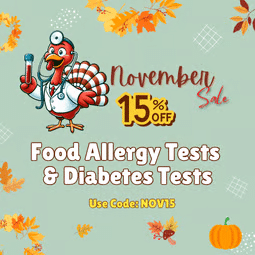Essential Facts You Should Know
Food allergies represent a serious health concern affecting millions of Americans, with specific foods triggering immune responses that can range from mild discomfort to life-threatening emergencies. Understanding which allergens pose the greatest risks and how to identify them is crucial for maintaining your health and safety. The “Big Nine” allergens—milk, eggs, peanuts, tree nuts, soy, wheat, fish, shellfish, and sesame—account for approximately 90% of all food allergic reactions, making awareness and proper testing essential for anyone concerned about their dietary safety.
What Are the “Big Nine” Food Allergens?
The Big Nine allergens represent the most significant food safety concerns in the United States, responsible for the vast majority of allergic reactions. These nine foods have been officially recognized and regulated due to their prevalence and potential severity of reactions.
The Complete List of Major Allergens
The nine major food allergens include milk, eggs, peanuts, tree nuts, soy, wheat, fish, shellfish, and sesame. This comprehensive list was established to help consumers identify potentially dangerous foods and enable manufacturers to provide clear labeling. The most recent addition to this list occurred when sesame became the ninth major allergen under the FASTER Act, which took effect on January 1, 2023.
The inclusion of sesame reflects growing awareness of its allergenic potential and increasing prevalence in the American diet. This legal designation ensures that sesame must be clearly labeled on food products, providing crucial information for consumers who need to avoid this allergen.
Understanding Food Allergy Risks
Food allergies pose varying degrees of risk, from uncomfortable symptoms to medical emergencies requiring immediate intervention. The severity of reactions can differ significantly between individuals and allergens, making personalized awareness and management strategies essential.
Severity of Allergic Reactions
Food allergic reactions encompass a wide spectrum of symptoms, with some individuals experiencing mild symptoms like hives and itching, while others face severe, life-threatening anaphylaxis requiring immediate epinephrine treatment. Anaphylaxis represents the most serious form of allergic reaction, potentially affecting multiple body systems simultaneously and demanding emergency medical intervention.
The unpredictable nature of allergic reactions means that someone who previously experienced only mild symptoms could potentially develop more severe reactions upon subsequent exposure. This variability underscores the importance of taking all food allergies seriously, regardless of past reaction severity.
Age-Related Patterns in Food Allergies
Food allergy patterns show distinct differences between children and adults, with certain allergens being more prevalent in specific age groups. Milk and egg allergies are most common in children, while shellfish allergies predominantly affect adults. Understanding these patterns helps healthcare providers and families anticipate potential allergy development and management needs.
Children often show different allergy profiles compared to adults, with some allergies being outgrown over time while others persist into adulthood. This age-related variation in allergy presentation emphasizes the need for ongoing monitoring and testing throughout different life stages.
Persistence and Outgrowth of Allergies
The likelihood of outgrowing food allergies varies significantly depending on the specific allergen involved. Approximately 80% of children outgrow milk allergies by age 16, demonstrating that some childhood allergies do resolve over time. Egg allergies also show relatively high rates of resolution during childhood and adolescence.
However, peanut, tree nut, and shellfish allergies often persist throughout life, requiring long-term management strategies and continued vigilance. These persistent allergies also carry higher risks of severe reactions, making proper identification and management even more critical.
Individual Allergen Profiles
Each of the Big Nine allergens presents unique characteristics, prevalence patterns, and management challenges. Understanding the specific properties of these allergens helps individuals make informed decisions about testing and dietary management.
Milk and Egg Allergies
Milk and egg allergies represent the most common food allergies in childhood, affecting millions of young children across the United States. These protein-based allergies typically develop early in life and can cause reactions ranging from digestive upset to severe systemic responses. The encouraging news is that many children do outgrow these allergies, with milk allergies showing particularly high resolution rates.
Egg allergies can be particularly challenging to manage due to eggs’ widespread use in processed foods and baked goods. Parents and caregivers must become skilled at reading ingredient labels and identifying hidden sources of egg proteins in manufactured foods.
Peanuts and Tree Nuts
Peanut and tree nut allergies are among the most serious food allergies, carrying high risks of anaphylaxis and typically persisting throughout life. Peanut allergies have shown a greater than 20% increase in children between 2010 and 2017, indicating a growing public health concern. This trend has prompted increased research into prevention strategies and treatment options.
Tree nut allergies encompass reactions to various nuts including almonds, walnuts, cashews, pistachios, and others. Cross-reactivity between different tree nuts is common, meaning individuals allergic to one type of tree nut often must avoid all tree nuts to prevent reactions.
Soy and Wheat Allergies
Soy and wheat allergies present particular challenges due to these ingredients’ widespread presence in processed foods. Soy appears in countless food products as soy lecithin, soybean oil, and various other forms, making complete avoidance challenging without careful label reading. Similarly, wheat allergies require vigilance regarding not just obvious sources like bread and pasta, but also less apparent sources in sauces, seasonings, and processed foods.
Wheat allergies differ from celiac disease, though both conditions require wheat avoidance. Understanding this distinction is important for proper medical management and dietary planning.
Fish and Shellfish Allergies
Shellfish allergy represents the most common food allergy among adults, affecting millions of Americans. This category includes both crustaceans (shrimp, crab, lobster) and mollusks (clams, oysters, scallops), with many individuals allergic to one or both groups. Fish allergies, while less common than shellfish allergies, can be equally severe and typically persist throughout life.
Cross-contamination concerns are particularly significant with seafood allergies, as cooking surfaces, utensils, and even airborne particles from cooking seafood can trigger reactions in sensitive individuals.
Sesame Allergy
Sesame allergy represents the newest addition to the major allergen list, reflecting its growing recognition as a significant health concern. The challenge with sesame lies partly in its appearance under various names in ingredient lists, including tahini, sesame seeds, benne seeds, and various Middle Eastern and Asian food preparations. The recent legal requirement for clear sesame labeling helps address this issue, but consumers still need awareness of alternative names and potential cross-contamination sources.
Food Labeling and Safety Regulations
Food labeling regulations play a crucial role in protecting individuals with food allergies by requiring clear identification of major allergens. Understanding these regulations and how to interpret food labels effectively can mean the difference between safety and serious health consequences.
Current Labeling Requirements
United States federal law requires that all Big Nine allergens be clearly labeled on food products, either in the ingredient list or in a separate “Contains” statement. This labeling requirement covers all packaged foods sold in the United States, providing consumers with essential information needed to make safe food choices.
The labeling laws also apply to foods sold in restaurants and other food service establishments, though the specific requirements and implementation can vary. Understanding your rights as a consumer and knowing how to communicate effectively with food service staff about allergies is essential for dining safety.
Cross-Contact Prevention
Cross-contact occurs when allergens are unintentionally transferred from one food to another, potentially making otherwise safe foods dangerous for allergic individuals. This can happen during manufacturing, food preparation, or even storage processes. Understanding cross-contact risks and prevention strategies is essential for maintaining allergen-free environments.
Manufacturing facilities often process multiple products containing different allergens, creating potential cross-contact situations. Many food manufacturers include advisory statements like “may contain” warnings to alert consumers about potential cross-contact risks, even when allergens are not intentional ingredients.
How to Manage Food Allergies
Effective food allergy management requires a comprehensive approach involving emergency preparedness, daily safety practices, and ongoing medical monitoring. Developing and maintaining these management strategies can significantly reduce the risk of serious allergic reactions.
Emergency Response Protocols
For individuals with severe food allergies, carrying epinephrine auto-injectors represents a critical safety measure. These devices can provide life-saving treatment during anaphylactic reactions, but they must be readily accessible and individuals must know how to use them properly. Emergency action plans should be developed with healthcare providers and shared with family members, schools, and workplaces.
Training family members, friends, and caregivers on recognizing allergic reaction symptoms and properly administering emergency medications can make a crucial difference in emergency situations. Regular practice and review of emergency procedures help ensure effective responses when seconds count.
Daily Safety Strategies
Managing food allergies in daily life requires consistent attention to food sources, preparation methods, and environmental factors. Reading ingredient labels carefully, asking detailed questions about food preparation in restaurants, and maintaining allergen-free spaces at home form the foundation of effective allergy management.
Communication plays a vital role in allergy safety, whether informing restaurant staff about allergies, educating family members about cross-contact prevention, or ensuring schools have proper allergy management protocols. Clear, confident communication about allergy needs helps create safer environments.
Testing and Diagnosis Options
Proper allergy testing provides the foundation for effective management by identifying specific allergens and reaction patterns. Various testing methods are available, including skin prick tests, blood tests measuring specific IgE antibodies, and elimination diets supervised by healthcare providers. Walk-In Lab offers convenient access to comprehensive allergy testing panels, allowing individuals to identify their specific sensitivities and develop appropriate management strategies.
Understanding your specific allergy profile through professional testing enables more targeted avoidance strategies and helps healthcare providers develop appropriate treatment plans. Regular follow-up testing may be recommended to monitor changes in sensitivity levels over time.
Frequently Asked Questions
What are the nine most common food allergens?
The nine major food allergens are milk, eggs, peanuts, tree nuts, soy, wheat, fish, shellfish, and sesame. These allergens account for approximately 90% of all food allergic reactions and are subject to special labeling requirements.
Why was sesame added to the major allergen list?
Sesame was added as the ninth major allergen due to its increasing prevalence and the severity of reactions it can cause. The FASTER Act, effective January 1, 2023, requires clear labeling of sesame in food products to help consumers avoid accidental exposure.
Can food allergies be outgrown?
Some food allergies can be outgrown, particularly milk and egg allergies in children. However, peanut, tree nut, and shellfish allergies typically persist throughout life. Regular medical monitoring can help determine if allergies have been outgrown safely.
What age groups are most affected by different allergens?
Children are most commonly affected by milk and egg allergies, while adults more frequently develop shellfish allergies. Peanut and tree nut allergies can develop at any age and often persist throughout life.
What symptoms indicate a food allergy?
Food allergy symptoms can range from mild reactions like hives, itching, or digestive upset to severe anaphylaxis involving difficulty breathing, swelling, rapid pulse, and loss of consciousness. Any suspected severe reaction requires immediate emergency medical attention.
Conclusion
Understanding the Big Nine food allergens and their associated risks empowers individuals to make informed decisions about their health and safety. From the widespread childhood allergies to milk and eggs, to the serious lifelong concerns presented by peanuts, tree nuts, and shellfish, each allergen requires specific awareness and management strategies. The recent addition of sesame to this critical list underscores the evolving nature of food allergy science and the importance of staying current with allergy information.
Whether you’re managing existing allergies or concerned about potential sensitivities, proper testing provides the foundation for effective management. Taking proactive steps to identify your specific allergy profile through comprehensive testing can help prevent serious reactions and enable you to live confidently with food allergies.
Ready to take control of your allergy concerns? Order Walk-In Lab’s comprehensive allergy testing panels today to identify your specific sensitivities and develop an effective management plan with the guidance of healthcare professionals.






